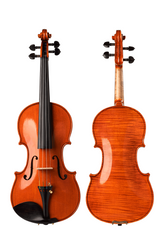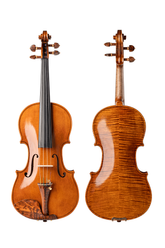What Are the Best Violin Strings Made Of?
Beginners often ask me what the best violin strings are made of. They tend to feel confused about things they are unfamiliar with. Today, I’ll explain violin strings in detail for you.

1. What are the best violin strings made of?
Violin strings can be made from different materials. The most common materials are metal, synthetic (nylon), and gut strings. In the metal category, you’ll find steel, silver, and gold strings. Synthetic strings are a modern development, offering a balance between the robustness of steel strings and the delicate sound of gut strings. Gut strings, on the other hand, are the most traditional, with a long history, and many famous violins use them. However, they are more expensive and prone to breakage.
Each type of violin string has its own characteristics. In terms of price, steel strings are the cheapest, while synthetic and gut strings are relatively more expensive. As for which material makes the best violin string, it’s hard to say. You can’t just look at the strings alone. A violin is a complete instrument, and the best strings depend on the unique sound characteristics of each violin. So, there is no absolute best—only the most suitable.
2. The Four Violin Strings: E, A, D, and G
A violin has four strings: E, A, D, and G. Each string covers a different range of notes, with the E string being the highest and the G string the lowest. The thickness of each string also differs—E is the thinnest, and G is the thickest. If you need to replace one string, make sure to buy the corresponding one, or you may want to replace the entire set. Below is a brief description of each string’s tonal characteristics, which beginners can familiarize themselves with:
- G string: The lowest-pitched string, ranging from G3 to D5. This string is often used to play deep, solemn melodies or chords, giving a sense of gravity and dignity. The sound here is rich and powerful, capable of expressing deep emotions.
- D string: Ranging from D4 to A5, slightly higher than the G string. This range allows for brighter and more lively melodies. The tone is warm, providing a feeling of comfort. In this range, the violin's sound is soft and expressive.
- A string: Ranging from A4 to E6, higher than the D string. This range is ideal for high-pitched, passionate melodies, expressing energy and motion. The tone is bright and penetrating, giving a sense of vitality and enthusiasm.
- E string: The highest string, with a range from E5 to E7. This high range produces clear and bright tones. The E string's sound is pure and refreshing, offering a light and airy feel.
These four different string characteristics give the violin its ability to express a wide variety of emotions and tonal qualities.
3. The Unique Accessory for the E String
Compared to the other three strings, the E string has an additional piece of equipment known as the "E String Protection Pad." This is because, when playing the violin correctly, significant pressure is applied to the bridge, and the E string, being the thinnest, faces even greater pressure. Over time, this can cause problems for both the string and the bridge. So, high-quality violins usually come with an E String Protection Pad, often made of leather, placed on the bridge to protect it.
4. The Best Violin Strings for Beginners
For beginners, I recommend metal or synthetic strings. They are durable, strong, and produce loud sounds, which makes them suitable for beginners. As for brands, D’Addario and Thomastik are excellent choices. Both brands offer quality strings at reasonable prices.
Follow Fiddlover Violin Shop for more violin information.






